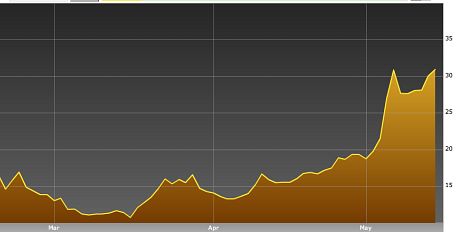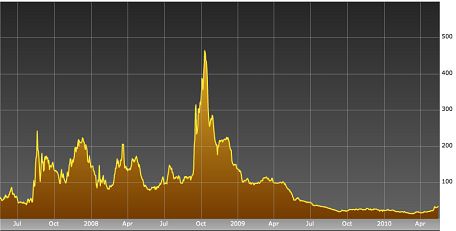Bloomberg and the Financial Times are good to emphasize that the banking system—at least in Europe—is shuddering yet again in a manner that calls pre-September 2008 to mind.
Bloomberg’s lede:
Europe’s banks are facing déjà vu. Less than two years after the collapse of Lehman Brothers Holdings Inc., fresh tremors in the debt markets are threatening to shake the financial system.
Libor, which measures how much banks charge each other for short-term loans, is shooting up again. That’s important because Libor is sort of a leading indicator of the credit crisis.
The FT‘s lede yesterday:
Concern about the exposure of European banks to the debts of weaker countries in the eurozone is stoking growing risk aversion in money markets and increasing the amounts banks charge to lend to each other.
I thought in the spring and summer of 2008 that the press wasn’t aggressive enough about the implications of the worsening crisis. Bloomberg, by contrast, doesn’t pussyfoot around here:
“There’s a concern this may be Lehman II,” said Konrad Becker, a Munich-based banking analyst at Merck Finck & Co. “The direct risks of writedowns and loan defaults combined with indirect ones such as mistrust between banks could lead to a systemic crisis.”
The FT piece is one of its trademark once-over-lightly stories that leaves out key information and context. In this case, we’re not told how the Libor situation compares to the one we saw in 2008.
An accompanying chart, pretty as it is, only goes back to June 2009. And that chart shows the overnight rate and the three-month rate. The overnight rate looks much worse than the three-month, but it isn’t even mentioned in the story. Why not?
Bloomberg doesn’t mention the 2008 comparison, either, although its story has a slightly broader focus.
Libor has doubled in three months now. So what’s doing with the TED spread? which is the difference between three-month Libor and the three-month Treasury bond rate. It’s gone from almost zero to 31 basis points in two months.

That’s still low compared to the nearly 500 basis points it hit in late 2008, but it’s worth watching very closely.

UPDATE: I should have pointed out that the Times had a good story along similar lines on Monday. It’s particularly good in making a clear connection to our financial system:
Ryan Chittum is a former Wall Street Journal reporter, and deputy editor of The Audit, CJR’s business section. If you see notable business journalism, give him a heads-up at rc2538@columbia.edu. Follow him on Twitter at @ryanchittum.Because of the pullback by American lenders, the rate banks charge one another for overnight loans, known as Libor for the London Interbank Offered Rate, has been steadily climbing. And the significance of Libor stretches far beyond Europe’s shores: that is the benchmark that helps determine the interest rate on many mortgages and credit cards held by American consumers…
While the direct exposure of American banks to Greece is minimal, American financial institutions are closely intertwined with many big European banks, which in turn have large investments in the weaker European nations.

